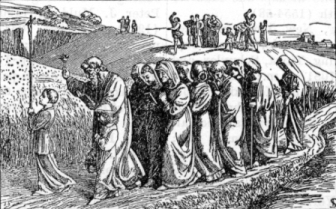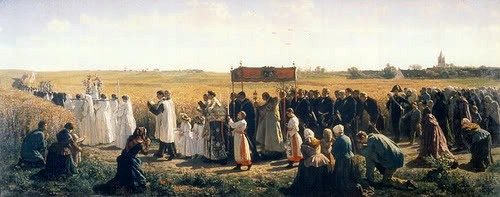 I didn’t get to this yesterday or “Feria Secunda in Rogationibus“.
I didn’t get to this yesterday or “Feria Secunda in Rogationibus“.
Rogation Days were on the traditional Roman calendar for 25 April (Major Rogation Day) and the three days before Ascension THURSDAY (Minor).
“Rogation” comes from rogo “to ask”.
For the Major days, the Greater Litanies were recited and there could be a procession and prayers for blessings on crops. Remember, people didn’t divorce prayer from the things which were critical for survival.
The Minor days included the Lesser Litanies. Again, there are prayers and blessings for crops, given that it is spring (at least in the northern part of the globe). There would be the ceremony of the “beating of the bounds”. The procession would go around the boundaries of the property, singing litanies and prayers.
The traditional Roman calendar more thoroughly integrates the mysteries of the Lord’s life and turning of the Earth into the passing days of our lives.
Reason #746 for Summorum Pontificum, if you ask me.



































That’s such a nice picture at the bottom of your post. Where did you find it?
Hmm, being from a province which is predominately farmland, and plagued with crop issues every year (alternating each year with drought and too much rain/floods), something such as this seems more fruitful than, oh I don’t know, Farmers’ Stations of the Crops.
*Cross! Not Crops. Lol, whoops.
…and Anglicanorum Coetibus.
The Rogation days, as well as the Ember days, are restored for the Ordinariate calendar.
http://anglicanusenews.blogspot.com/2012/03/calendar-and-sanctorale-for-ordinariate.html
Hmmm … Stations of the Crops
First Station: The seed falls by the wayside.
Second Station: The seed falls on stony ground.
Third Station: The seed falls on good ground.
Fourth Station: The seed springs and grows up night and day, the farmer knows not how.
Fifth Station: The smallest of seeds grows into the largest of bushes.
Sixth Station: The enemy sows tares.
Seventh Station: The angels reap the wheat and the tares.
Any other suggestions?
The Diocese of Evansville has celebrated a Rogation Day at the end of March for as long as I can remember. I think the previous Bishop resumed the practice when I was in elementary school.
It would probably be more expedient to employ driving these days as part of beating the bounds. It would be a long way to go with the humeral veil and monstrance if one were to circum-ambulate two thousand acres (I think that’s like 3-4 square miles, but I haven’t done conversions in a really long time).
Contramundum –
Eighth Station: The angels bind up the tares for the fire.
Ninth Station: The angels winnow the wheat from the chaff.
Tenth Station: The tares and the chaff go into the fire.
Eleventh Station: The angels bring the wheat before the Lord.
Twelfth Station: The angels send the enemy into the fire.
ha! can’t think of anything else :)
Aren’t Rogation and Ember days supposed to still be on the OF calendar, as per GIRM 394? I have never seen them done or even know what mass would be proper, but the text seems to say they should be on the calendar (not may or can).
@Father Z. I few years ago I actually got to do this in procession with my friends the monks of Clear Creek Abbey in Hulbert, OK! This was near Ascension Thursday as I recall. It was fantastic as you can imagine, as the litany of the saints in Latin was prayed as all the monks and laity there processed around the grounds near their enclosure, as the priest blessed the grounds with the Aspergillum. We stopped at a couple stational statues of Our Lady on the way also.
Pray fast and receive the Eucharist for the unity of the Church!
(What is perhaps gossip has it that the SSPX has a major meeting on Wednesday, 16 May. Don’t miss it!)
Re: driving the bounds, I believe that in some parishes in the world, they take pickup trucks or flatbeds, and drive in something of a parade fashion.
However (and if road safety isn’t an issue), you’ve got three days to walk the bounds of the parish, and today there wouldn’t be a concern for marking out secular or town or parish property lines, much less the whole business of making sure the youngest boy in the parish learns and remembers them. So walking the bounds should go quicker, unless your parish is in South Dakota.